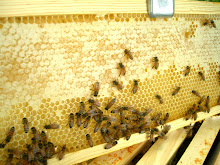After a summer of being a relatively bad bee mom, I lit the smoker, suited up and carried all my equipment out to check on Apollo. Apollo is my original and only hive.
Digressing for a moment here...I'd intended to start a second hive this summer and ordered a nuc from Pigeon Mountain Trading Company in Dalton, Ga. Due to the cold winter, the bees were much later in their production cycle this spring and delivery was delayed for many weeks. As the weeks passed by and I had travel plans during the summer, I decided to cancel my order. Let's just say customer service at Pigeon Mountain is extremely poor and their representatives are rude and make multiple excuses. I forfeited my deposit as expected, but Pigeon Mountain did nothing to try and retain my business. I will NEVER buy anything from them again. And yes, I did some research and found a bunch of complaints on file against them with the BBB. Live and learn. I'll stick with Brushy Mountain Beekeeping in N.C.
So, back to Apollo. The hive has three medium supers and a shallow honey super on top. I removed the shallow today and then was pleased to look down into the top two mediums to see that they are brood heavy and the queen is laying in a healthy pattern. Lifting the hive from the back, I could feel its weight. Heavy = full o' bees!
I took four frames of honey for harvest and left some for the bees. But now that nectar flow has tapered off with summer ending, the girls will need food. I'll start giving them simple syrup and then, when the weather turns colder, I'll make sure they have pollen patties and fondant for winter.
Linda Tillman, who writes an excellent blog on beekeeping, made a YouTube video of her "crush and strain" method of honey harvesting. This is a simple method for the backyard or beginning beekeeper.
First, using a serrated knife, I cut or scrape the honey from the frames into a pan. Then, I crush the honeycombs with a pestle.
Next, I pour the contents of the pan into a two-bucket strainer system. The top bucket is lined with a fine mesh bag with a metal strainer plate below.
The contents of the top bucket are strained and the filtered honey drips into the lower bucket, which is equipped with a gate. When the honey has finished filtering, I will fill individual bottles from the honey gate.
It's a hot and sticky process, but the results are so worth it! I love my girls and thank them for the hard work they do to help our environment and provide such a beautiful perfect food.
Subscribe to:
Post Comments (Atom)





So glad to see such and upbeat post after all the travail with the other two hives!! I love this practical description of the work you and the "girls" do. I remember in my long, long ago youth that we sometimes bought honey with the comb still in it. We loved breaking off parts of it and chewing it. Is there some reason you don't see that anymore -- or could you do it too in your process?
ReplyDeleteSome beekeepers do sell "cut-comb" honey — you can often find it at local farmers markets. I did try this a couple of years ago, cutting some comb and placing it in jars with liquid honey. There's a cool tool (that I don't yet have) that's great for cutting the comb into squares, and it sort of "seals" the edges so that the square stays intact.
ReplyDeleteI think the comb makes the honey look especially "natural" and rustic. It was fun to chew it.
ReplyDelete